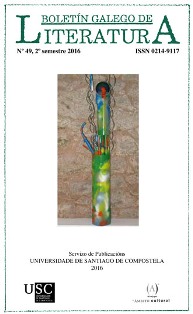Gender-based Violence in the Novel 'Y punto' by Mercedes Castro
Main Article Content
Abstract
This essay will focus on the analysis of the novel Y punto by Mercerdes Castro, particularly in the study of the protagonist, subdetective Clara Deza: a strong, foul-mouthed woman in a space dominated by man, in which she has to survive and stand up for herself. In this misogynist world, she has to face her first solving of a murder case. The feminine point of view will be one of the basis of the analysis: we will study Clara’s relationship with the oppresive masculine world that surrounds her. Clara’s thoughts bring the reader into her interior world, showing them a woman that has to balance her daily life with her work, something that seems very different from the life perspective of her masculine counterparts. Mercedes Castro presents a woman that knows she is a woman, who fights in the patriarchal world she lives in; but also a real woman, with contradictions, who suffers several types of violence inflicted by man. Thus, the analysis of this work is important, for it showcases some patriarchal behaviours that might go unnoticed in current society.
Keywords:
Article Details
References
Bonino Méndez, Luis. 1998. “Micromachismos, la violencia invisible en la pareja”, en http://www.luisbonino.com/pdf/mM96.pdf [Consulta: 31/03/2016].
Castro, Mercedes. 2008. Y Punto. Madrid: Alfaguara.
Colmeiro, José. 2015. “Novela policiaca, novela política”, en Lectora. Reviste des do-nes i textualitat, n.º 21, pp. 15-29, doi:10.1344/105.000002445, en http://revistes.ub.edu/index.php/lectora/article/view/105.000002445/17653[Consulta: 31/03/2016].
Facio, Alda. 1999. “Feminismo, género y patriarcado”, en Justicia y Género. http:// justiciaygenero.org.mx/publicaciones/facio-alda-1999-feminismo-genero-y-patriarcado/[Consulta: 31/03/2016].
García, Luis. s.d.. “Entrevista a Mercedes Castro”. http://www.literaturas.com/ v010/sec0803/nuestro_novel/nuestronovel.htm[Consulta: 31/03/2016].
Lerner, Gerda. 1986. The Creation of Patriarchy. New York: Oxford University Press.
Mora, Rosa. 30 maio 2009. “Conversación: Maestros de la España negra”, en El País. http://elpais.com/diario/2009/05/30/babelia/1243641015_850215.html [Consulta: 17/03/16].
Pineda, Esther. 21 outubro 2013. “La violencia estética contra la mujer”, enPalabra de mujer. https://palabrademujer.wordpress.com/tag/violencia-estetica-contra-la-mujer/[Consulta: 17/03/16].
Sánchez Zapatero, Javier e Àlex Martín Escribà.2013. “Manuel Vázquez Montalbán y la novela negra del desencanto”, en Cuadernos de Estudios Manuel Vázquez Mon-talbán, volume 1, nº 1, pp. 46-62, en https://www.journals.uio.no/index.php/MVM/article/view/585/602[Consulta: 17/03/16].
Silió, Elisa. 2 febreiro 2008. “Entrevista: La vida cotidiana en la novela policiaca”, en El País, http://elpais.com/diario/2008/02/02/babelia/1201913416_850215.html[Consulta: 17/03/16].
Suárez Lafuente, Socorro. 2013. “Desarrollo de las detectives en la literatura contem-poránea”, en Raudem, Revista de estudios de las mujeres, nº 1, pp. 167-182, http://www2.ual.es/raudem/index.php/Audem/article/view/13 [Consulta: 17/03/16].
Walker, Lenore E. A. 2000. The Battered Woman Syndrome. New York: Springer.






